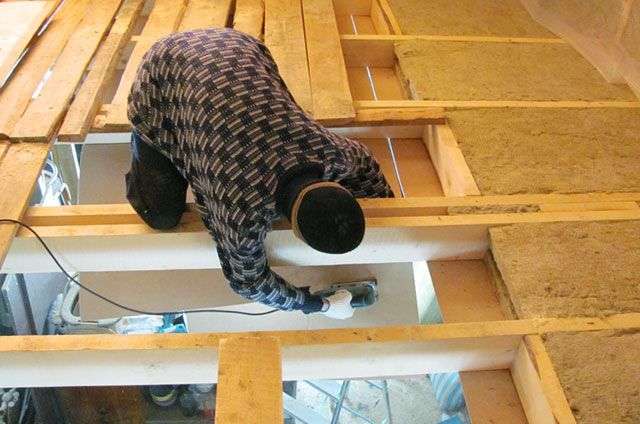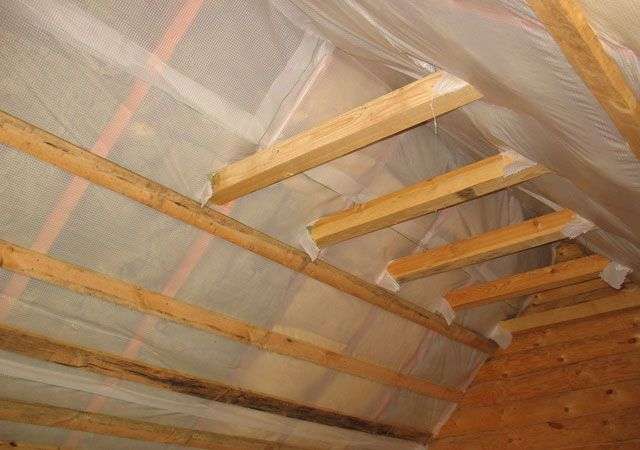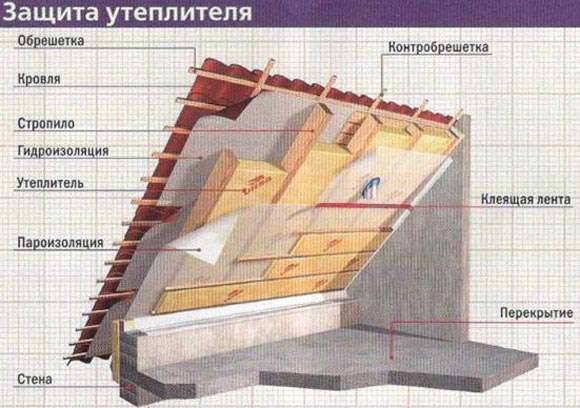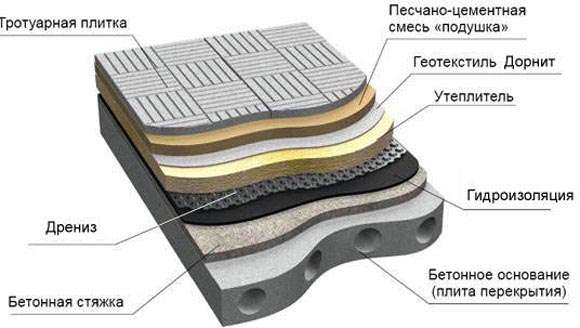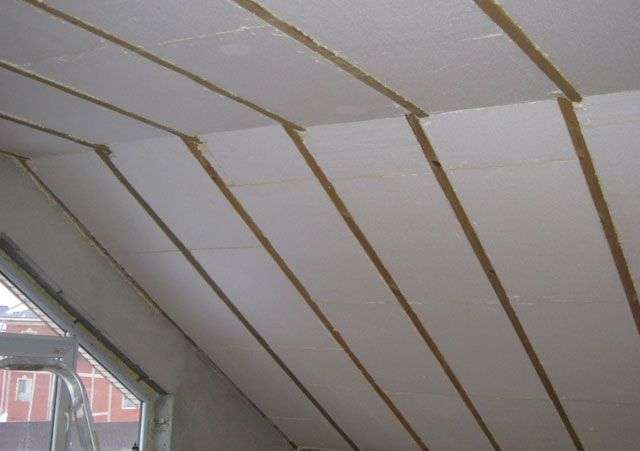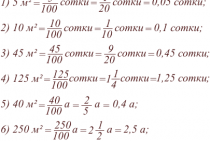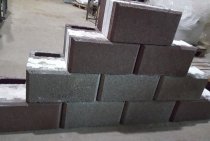Roof insulation with mineral wool
Varieties of mineral wool and options for mounting the material on various types of roofs, the pros and cons of coatings based on fibrous products, the rules for choosing components, installation technology.
- Features of work
- Advantages and disadvantages
- Warming technology
- The choice of mineral wool
- sloping roof
- flat roof
Roof insulation with mineral wool is the creation of a shell for comprehensive protection of the house from cold, overheating, and precipitation. The composition of the thermal insulation coating includes, in addition to the main element, vapor and waterproofing materials, a screed for protection against mechanical stress. You can learn about the rules for the formation of a warming "pie" from this article.
Attic floor insulation
Of course, it will be easiest to install thermal insulation during the construction of the building - this will simplify the design and some of the nuances of work. In most cases, following this advice will not work - a lack of finances or time may well interfere, so the ceiling remains without insulation. As a rule, this state of affairs persists until the first frosts, and the owners have to hastily lay thermal insulation.
Before you insulate the attic floor, you need to carry out a number of preparatory work, which is especially important when using loose heat-insulating materials. There are two technologies of insulation - traditional and modern.
The traditional method of floor insulation is implemented as follows:
- First of all, it is necessary to treat the boards attached to the ceiling with clay or lime mortar - such treatment will ensure the tightness of the structure while maintaining normal ventilation;
- When the mixture hardens, you can proceed directly to the insulation work - filling bulk materials into the space between the floor beams on pre-treated boards.
Today, a more modern method of floor insulation is much more often used:
- First of all, a vapor barrier membrane is laid on the floor and beams with a 20-cm overlap, which will not only protect the insulation material, but also complement its thermal insulation properties, reducing the amount of heat leaving the building through the ceiling;
- For tightness, the membrane in the places of overlap must be sealed using construction tape;
- The next step is the installation of the selected insulation (mineral wool, ecowool, expanded clay or one of the bulk materials) according to the appropriate technology;
- So that the floor beams do not have cold bridges, care must be taken that the insulation passes through them;
- Above the insulation, in compliance with the already known rules, another layer of vapor barrier film is laid, which is attached to the beams with counter rails;
- It remains to lay a coating of boards or sufficiently strong plywood over the finished heat-insulating structure.
Sometimes, instead of insulating the floor from the side of the attic, thermal insulation is laid inside the building itself. This design is also quite effective in the matter of insulation, but requires additional finishing.
Vapor barrier materials
The most popular vapor barrier material is a special film that protects wood and insulation from the effects of steam, which turns into condensate as a result of temperature changes. The negative impact of moisture on the elements of the roof structure can not be mentioned once again - suffice it to say that it significantly reduces the life of the roof and the effectiveness of the heat-insulating material.
The vapor barrier membrane is attached to the roof or ceiling before the thermal insulation materials are laid.In rooms where heating is carried out, vapor barrier should be installed only under a layer of finish. To protect structures that are constantly in conditions of temperature contrast, a vapor barrier layer must be placed on both sides. An exception is concrete floors that do not require such protection.
To equip the vapor barrier layer, a film with different characteristics can be used. The simplest option is a non-woven film, but a foil membrane is a much more effective option. The latter option, as its name implies, has a thin layer of foil on one side, which prevents heat from escaping outside the structure. The vapor barrier of the roof installed from inside the house is connected with a special adhesive tape, which ensures a tight connection.
The choice of material for insulation
To date, the choice of thermal insulation materials is so large, and their characteristics are so different that it can be very difficult to make the right choice for a particular case.
Most often, developers as a heater prefer the following materials:
- glass wool;
- mineral wool;
- basalt (stone) slabs (there are ready-made sandwich panels with basalt insulation);
- polystyrene foam (polystyrene foam);
- polyurethane foam (liquid sprayed insulation).
Recently, Izover, a fiberglass material with a high level of heat and sound insulation, has been especially popular for insulating pitched roofs. Due to the content of air in the structure of this material, its low thermal conductivity is ensured, not exceeding 0.044 W / mK. In addition, this material has amazing durability (at least fifty years), excellent vapor permeability and high fire resistance (combustibility class - G1).
Considering other types of roof insulation, you should pay attention to expanded clay. It is also characterized by excellent heat and sound insulation, environmental friendliness and fire safety.
Since clay is used for its manufacture, it does not lose its properties under the influence of temperature, does not deform and does not emit any substances harmful to humans, which is possible if synthetic heat-insulating materials are used.
Instructions for warming a pitched roof

The entire installation process can be divided into several stages of work:
Stuffing on the rafter legs on the inside of the crate boards in increments of 20 to 30 cm - they are needed to fix the insulation.
Mineral wool is laid on the outside of the rafter legs. If insulation is installed for cold regions, it is better to increase the number of layers to two or three. The main condition for work is the tight pressing of the joints of the plates to the rafter legs
It is important to ensure that there are no through holes in the mineral wool layer. If after installation you still notice holes, then they must be eliminated with mounting foam.
When the laying of mineral wool is completed, it is necessary to install a waterproofing membrane
To do this, it is simply nailed to the rafter legs, leaving a slight sag. Mounting "in tension" is not desirable. The waterproofing membrane must be properly positioned. The fact is that such material has a front and back side. The first is designed to prevent the passage of moisture, but the lower one, on the contrary, allows moisture and vapor to pass upward.
The waterproofing material is laid in strips, leaving a small overlap. It is also necessary to create a gap of 5 cm between the membrane and the mineral wool.
When the waterproofing material is attached in place, we move on to the additional ventilation device. To do this, wood blocks with a section of 25x50 or 50x50 cm are stuffed onto the rafter legs. They can be trimmed bars.The length can vary from one to two meters.
When the bars are in place, it is necessary to fill the crate, placing the boards across the rafter legs. This will create a gap that will allow the evaporation of condensate and moisture that will collect on the waterproofing membrane. Roofing material is laid on the crate. Do not forget about the treatment of wood with antiseptic solutions. This will help increase the life of the roofing pie structure.
Creating a vapor barrier is an important step in roof insulation. It will prevent water vapor from entering the mineral wool. The vapor barrier film is stretched over the inside of the truss system.
To be able to finish the room, it is necessary to lay the batten boards on top of the vapor barrier material. For this, slats are used, on which the inner lining in the form of lining, drywall, plywood, etc. will be attached later.
Features of roof insulation from the inside with mineral wool, and the cost of work
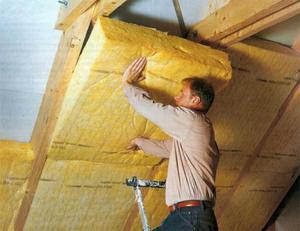
Basalt or stone wool is made from rock. It serves a very long time, therefore it is used for capital construction. The most expensive type of mineral wool.
Glass wool made from the same components as ordinary glass. Cheaper than basalt, but its service life is much shorter. It is used in places where it can be quickly and cheaply replaced.
Slag wool, for the manufacture of which waste from blast furnaces is used. The price and properties are similar to glass wool.
These materials are available in a variety of formats. It can be plates, and rolls, and mats, and cylinders.
Glass wool roof insulation from the inside is the most effective and affordable way to keep heat in the attic.
In order to insulate the roof from the inside, especially when it comes to wooden structures, materials that meet serious requirements should be used. They should be:
- Not combustible (fire safety class from G3 and above).
- durable.
- Eco-friendly.
- Rot resistant.
- Possessing not only warming, but also soundproofing properties.
- Not affected by temperature fluctuations.
- Resistant to damage from insects and rodents.
Most of all, these requirements are met by mineral wool. To insulate the roof from the inside, mineral wool is used in the form of a roll or mattress. The last option is the most convenient in installation.
Prices for mineral wool allow almost every owner of a cottage, bath or garden house to use it to insulate the roof.
The only disadvantage of this material is its ability to absorb water, while losing up to 40% of its thermal insulation properties. However, the insulation of the roof from the inside with mineral wool, carried out in strict accordance with the technology, helps prevent liquid from entering the insulation.
Well, the quality of roof insulation can be seen with the help of a thermal imager, which can instantly show the places through which heat loss occurs.
What set of tools and consumables will be needed to insulate the roof from the inside?
When carrying out roof insulation on your own, you should prepare everything necessary for the work:
- Minvat.
- Wooden bars with a section of 40 mm.
- Vapor barrier (for example, any waterproofing film).
- Drill.
- Glue.
- Antiseptic solution for wood.
- Nails or screws.
- Hammer.
- Mineral wool respirator.
Features of mineral wool
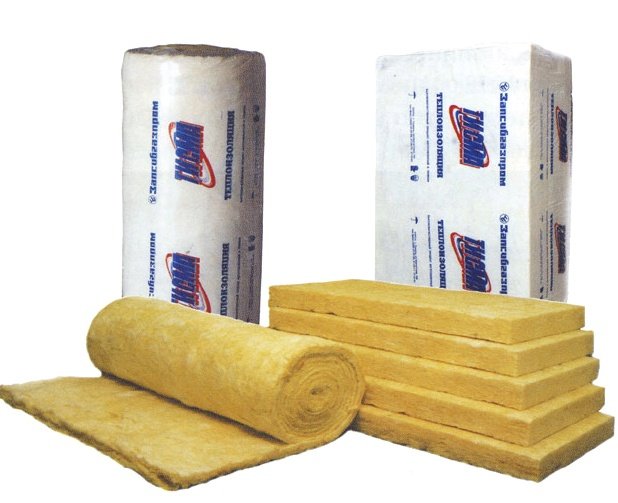
Mineral wool is not in vain very popular as a heater. This material is easy to work with, and it has a number of advantages, among which are:
- low thermal conductivity;
- resistance to burning;
- environmental friendliness;
- resistance to aggressive environments;
- high level of heat saving;
- good sound absorption;
- hydrophobicity. This property manifests itself as resistance to getting wet; You cannot rely only on the hydrophobic qualities of mineral wool. Be sure to take measures to protect the under-roof space from moisture. When wet, any insulation will reduce its effectiveness by a couple of times.
- high resistance to deformation;
- ease of installation;
- length of service life.
Unlike foam, careless transportation of the material will not damage it. And thanks to the softness of mineral wool, it is easy to install.
Despite similar warming procedures, mineral wool differs from ecowool, which appeared not so long ago on the construction market, which is an insulator that is characterized by friability and light weight. Ecowool contains cellulose, antiseptics and boric acid.
flat roof insulation
Quite often, flat roofs of houses are used to equip terraces, winter gardens, sports or playgrounds. Therefore, such a design should be as reliable as possible and able to withstand significant loads, and the thickness of the insulation for the roof should also be quite significant (also read: "House Roof Diagram - Features").
Insulation of such a roof is carried out as follows:
- first, a cement screed is installed on the reinforced concrete floor slab, forming a slope. Then a layer of waterproofing is laid;
- after that, extruded polystyrene foam with a density of at least 35 kg per square meter is laid in a layer;
- then, to create filtration, everything is covered with fiberglass, covered with a layer of gravel or pebbles, and finally paving slabs or paving stones are laid.
Foam for roof insulation or foam concrete can also be used, applied to the vapor barrier layer and covered with a foam fiber concrete screed. After that, a built-up or membrane coating of polyvinyl chloride is equipped.
In cases where flat roofs are used under the attic, and a soft roof with insulation is supposed to be installed, the vapor barrier layer and insulation are laid in the attic, and the waterproofing layer is laid under the roofing material. It is also possible to insulate the attic floor with expanded clay. If the operation of a flat roof is not foreseen, then it can be insulated both from the outside and from the inside (for more details: “Insulation of a flat roof and its features”).
Instructions for warming a flat roof
All flat roofs are divided into ventilated and non-ventilated. Let's look at both types.
Ventilated flat roof
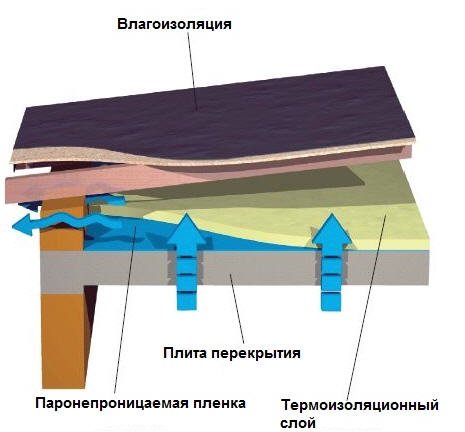
The process of its insulation is similar to the scheme of working with non-residential premises of the attic. Such a roof design provides a minimum distance between the slope and the ceiling, which makes it difficult to move in the under-roof space and reduces the functions of the room to only technical ones.
Mineral wool slabs 20 cm thick are suitable for work. The material is laid on the floor of the attic. Dowels are used as fasteners. In addition to the mechanical method of installation, it is allowed to use glue or hot mastic, but the latter method has not gained much popularity. For proper operation of the insulation under it, it is necessary to place the building film in one layer.
Stages of work
- To begin with, the condition of the entire roofing pie is checked. Damaged elements must be replaced.
- For additional insulation of the attic, it is possible to lay a layer of mineral wool on the existing one.
- Before starting the installation of mineral wool boards, the surface of the floor to be insulated should be cleaned.When using reinforced concrete floor slabs, a vapor barrier is not necessary, because concrete does not allow moisture to pass through.
- Beams must also be insulated or covered with insulating materials, or mats (you can use rolled insulation) between the beams. But before that, it is necessary to mount a vapor barrier layer.
- When using foil material, laying is carried out by placing the plates down with the foil.
- Leave a ventilation gap next to the eaves.
Non-ventilated flat roof
The structure of a non-ventilated flat roof
As a base, concrete slabs or wood are used, depending on the material from which the house is built. The peculiarity of this type of roof is the absence of any gap between the roof and the ceiling. Therefore, it is necessary to mount mineral wool directly on the base.
Stages of work
- The vapor barrier film is laid on the base of the roof.
- After that, you can start laying mineral wool boards. It is recommended to do this with a checkerboard arrangement of the material so that the joints are not located in one line. Fitting of plates must be carried out with a tight fit. The most suitable thickness of the thermal insulation layer is 25 cm.
- Next, the roofing material is laid on top of the mineral wool boards.
A non-ventilated flat roof can have various types of thermal insulation:
- Single layer. For this, rigid mineral wool boards are used, which have increased strength. But their thermal insulation qualities are not great.
- Two layer system. For this, elastic plates are suitable for forming the first row, and harder ones are used for the second. Thus, a structure is obtained in which the lower layer exhibits excellent thermal insulation qualities, and the upper one helps to compensate for the sensitivity of the first row to various mechanical damage. Basalt mineral wool is used as the material.
- Mixed system of two layers. This option is similar in execution to the previous one, but differs in the use of two types of mineral wool boards. Glass wool is used for the lower layer, and basalt wool for the upper layer.
Thermal insulation methods
Depending on which structural element of the building is insulated, 2 methods can be distinguished.
Thermal insulation of the floor
The first option is floor insulation. The method is inexpensive and very easy to implement. It consists in laying wool on concrete base slabs or, in the case of a wooden floor, between structural elements. Any kind of mineral wool will do, even soft and granular. Laying is simple, it is not required to bypass the rafters, as when insulating roof slopes, you can easily fill all the gaps and cracks.
Thermal protection of slopes
The second option is the insulation of the roof slopes. If the room in the attic is not in use, then this option is not economically viable. The consumption of materials increases significantly, it takes more time due to bypassing the rafters and additional fastening of the mineral wool.
Insulation of slopes can be done in two ways: over open rafters or between them. In the first option, wooden beams remain visible inside the room and have an additional decorative function.
Pitched roof insulation
The technology for insulating a pitched roof depends on its structural features, as well as on the purpose of the attic. So, if the attic is non-residential, then the insulation is laid on the ceiling (attic floor), and not between the rafters. If mineral wool is used, then the following roof insulation scheme is recommended, a photo of which can be seen on the pages of many specialized publications or websites: running ladders are made along the attic logs, and a special membrane is laid on the wool layer, which provides steam removal and fiber filtration.After that, the floor is sewn up with OSB boards, and any floor covering is laid on top of them (useful article: "Types of roofing pitched roofs").
How to properly insulate a pitched roof, look at the video:
https://youtube.com/watch?v=C4QOujBaYVQ
In the event that a residential attic is planned, then they resort to a different insulation technology:
How to make a roof insulation with mineral wool from the inside
Roof slopes can be equipped using different technologies, but their design always includes a heat-, hydro- and vapor barrier layer, as well as a counter-lattice that creates a ventilation gap and is used for additional fastening of materials.
Roof installation technology involves the following steps:
- Waterproofing is laid on the assembled and installed rafter system. Most often, high-density polyethylene is used as a waterproofing material, which can protect the roof from both moisture and gusty winds. The waterproofing of the roof is laid from the inside of the house with an overlap of about 20 cm and is attached to the rafters with a construction stapler.
- A counter rail is installed above the film along each rafter. This element forms a small gap between the film and the roofing, due to which the structure is constantly ventilated.
- For laying a soft roof, sheets of moisture-resistant plywood are attached above the counter-lattice. Before you insulate a metal roof, or a roof made of other solid roofing materials, you will need to create a regular crate with a qualitatively calculated distance between its elements.
- After the crate is assembled, you can start installing the roofing.

